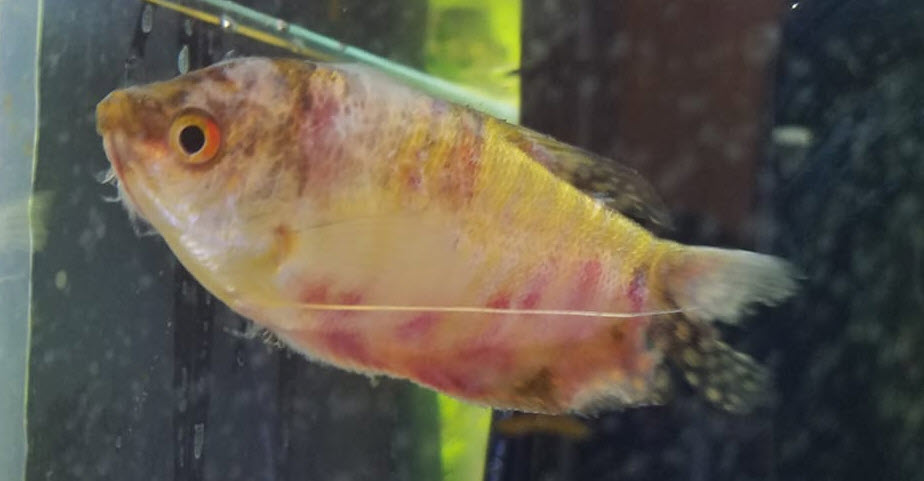
Most blood red blotches on the fins or skin of tropical fish are blood under the skin or hemorrhagic septicemia (“Red Pest”), an internal bacterial disease. The bacteria is generally a gram negative bacteria, with aeromonas bacteria being the chief culprit.
Hemorrhagic septicemia is a very serious conditions from which fish have very high mortalities, even with antibiotic treatment. Many experienced fish keepers use a “nuclear option” to treat hemorrhagic septicemia, with three treatment done simultaneously: antibiotics in the food, sulfa drugs and/or furans as a one hour baths and sulfa drugs and/or furans in the aquarium water.
There is a disease seen occasionally in pond fish that is a virus caused septicemia. But there appear to be no confirmed instances of it occurring in the tropical aquarium. This is probably because the virus is only virulent at temperature below 68 degrees F. (20 degrees C), (“Effect of water temperature shifting on mortality of Japanese flounder Paralichthys olivaceus experimentally infected with viral hemorrhagic septicemia virus”, Sano et al, 2009).
Here are a whole series of fish with bacterial hemorrhagic septicemia:
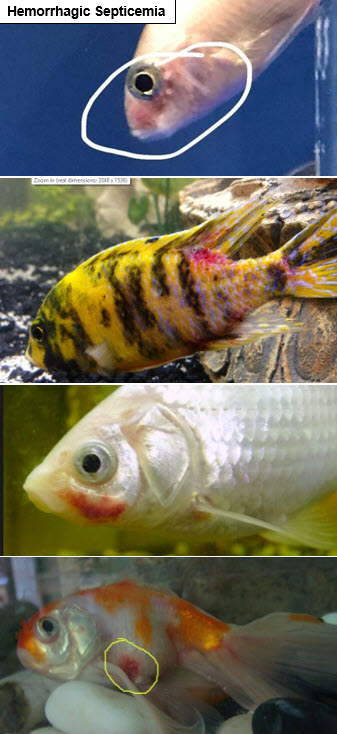

.
On particular type of bacterial septicemia is when goldfish get very red mouths. This is “red mouth disease” caused by the bacterium Yersinia ruckeri This is a serious disease which will kill the goldfish if not treated. The disease is treated exactly the same as any other bacterial septicemia. This disease is covered in this article:
“10.3.10. Red Mouth in Goldfish”
Here are two goldfish with red mouth disease:
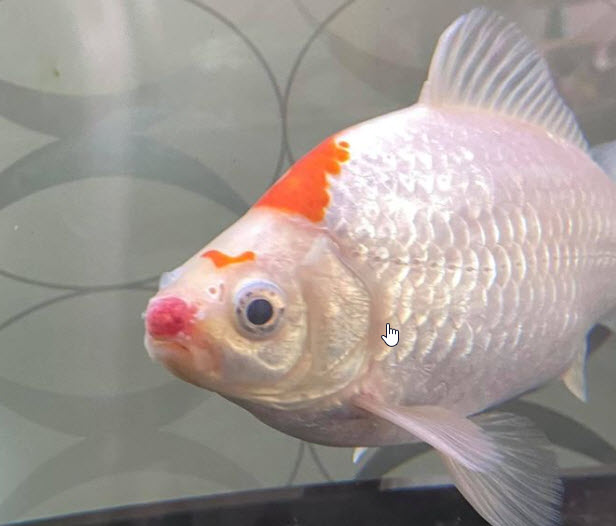

Red blotches such as these are most often septicemia caused by gram-negative bacteria (aeromonas, columnaris, etc.). The blood red patches are obviously just under or in the skin and scales of the fish. And the color varies from bright red to brownish red.
Note that carbon dioxide/ammonia poisoning during shipment can be mistaken for septicemia. The hemorrhages of carbon dioxide/ammonia poisoning are internal, typically inside the body cavity. The appearance of ammonia poisoning is quite different than septicemia. The ammonia builds up internally inside the fish. The ammonia inside the fish causes the internal organs to bleed. The body cavity (i.e. the belly) will take on a purple/red hue from blood. This purple/red color is much different than the brownish red blotches of septicemia.
Invariably when a posting comes on social media of a fish in an aquarium with obvious septicemia or even saddleback there will be several commentators who will chime in with “That fish has ammonia burn“. First off ammonia poisoning is actually extremely rare in aquariums. And it presents much differently than septicemia. The color is different and it is internal inside the fish, it does not occur in the skin or on the scales of the fish.

Treatment
Hemorrhagic Septicemia should be treated with broad spectrum antibiotics (Midland Vet Service Aqua-Mox, VetDepot Amoxicillin, Fishbiotic Ampicillin, Mardel Maracyn 2, SeaChem KanaPlex, API Fin And Body Cure).
Bacterial infections are most effectively treated with antibiotics in the food. Many believe (and the instructions on the antibiotics say!) that antibiotics need to be added to the water. They are simply incorrect. This controversial topic is covered in the following link:
12.5. Fish Don’t Drink
.

It is easy to make medicated food. Heat 1/4 cup water (two ounces or 58 milliliters, not a lot) in the microwave. Then blend seven grams of plain animal derived gelatin (Knox gelatin, one packet) into the hot solution with vigorous stirring. Take two tablespoons of dry commercial fish food (pellets or flake) and mix it with just a little of the hot water/ gelatin mixture. Add hot water/gelatin until you get a paste like consistency. If it gets too watery just add more food. To get gel food to float simply mix in a little whipped cream at this point.
Then add just a “smidgen” (roughly 1/16 teaspoon, a 1% to 2% addition) of medication to the mud. If you are using more than one medication mix the medications together, then use just a “smidgen” of the mixture. If you are using a packet of medication, take just a “smidgen” of the packet contents. Mix and mash the whole mass thoroughly.
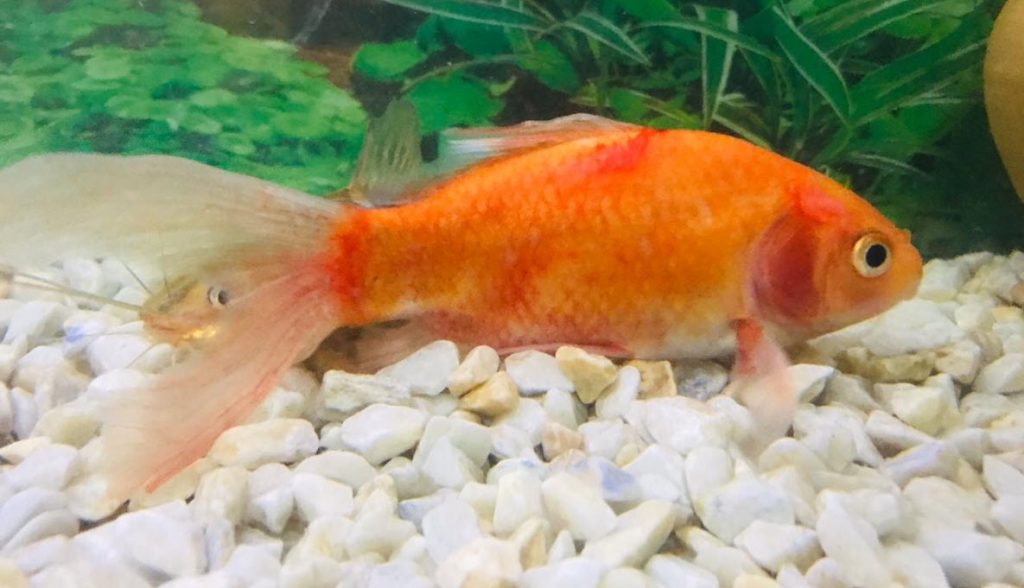
All the fish in the aquarium should be fed a steady diet of the antibiotic laced food for at least ten days. Note that the exact amount of medication which goes into the food is not very important. Antibiotics can be overdosed pretty much with abandon as they are only toxic in large doses over a period of months. Note antibiotics in the food do not affect the filters so they can be left in place and operating.
If you can’t resist the urge to treat the water, remove the biofiltration media (including sponge and/or foam) in the filters and put it in an open container for the duration of the treatment. Sometimes antibiotics kill the beneficial bacteria and sometimes they don’t. In any case the filter media will denature the antibiotics. Monitor the ammonia and would do a 50% water change if it spikes above 1 ppm. Reduce the amount of food fed by 2/3 rds.
Note that if antibiotics are not available, it is quite easy to take a pill or capsule of human antibiotic and use it for fish. If it is a pill just grind it up. Just be aware that the human antibiotics are about ten times more potent than the aquarium antibiotics, so just a “smidgen” in the food is more than enough. This is a very good option for the folks in Europe or Canada, where fish antibiotics are illegal.
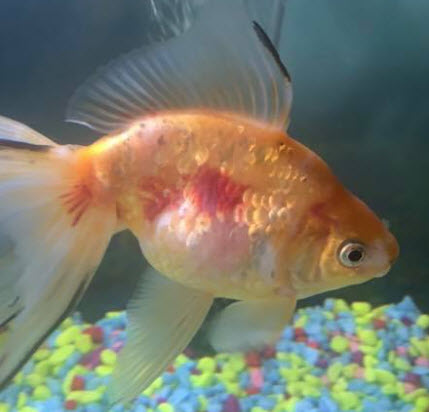
The “Nuclear Option”
Any internal bacterial infection which has become advanced enough to cause hemorrhaging under the skin of a fish is a very advanced bacterial infection. The mortality rate is going to be very high no matter what the treatment. It is always difficult to tell a fish keeper their fish are probably going to die but with hemorrhagic septicemia that is just the “cold hard facts”.
Many experienced fish keepers use a “nuclear option” to treat hemorrhagic septicemia, with three treatments done simultaneously:
- antibiotics in the food,
- sulfa drugs and/or furans as a one hour baths
- sulfa drugs and/or furans in the aquarium water.
There is only anecdotal evidence that this works but if one is so inclined one can do it.
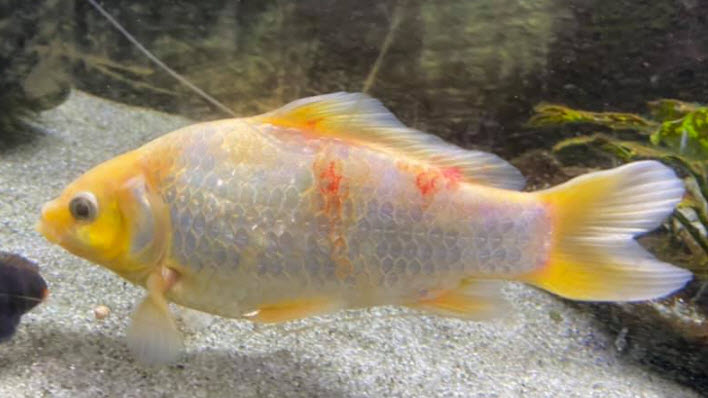
We cover antibiotics in the food above. Here is how to use the sulfa drugs or furans.
Sulfaguanidine, sulfathiazole, sulfamethazine and sulfacetamide are all what are called “sulfa drugs”. Mardel Maracyn Plus is a combination of two anti-bacterial drugs, sulfaguanidine and trimethoprim (trimethoprim is an antibiotic with an action which is very similar to furans). SeaChem SulfaPlex (Sulfathiazole) is a sulfa drug. API Triple Sulfa (Sulfathiazole, Sulfamethazine and Sulfacetamide) is a sulfa combination.
“Furans” include nitrofurantoin, nitrofurazone and furazolidone. Bifuran is nitrofurazone and furazolidone. SeaChem Focus is “polymer bound” nitrofurantoin. Sulfa and furans have very similar properties with furans being more toxic to fish than sulfa drugs,

To treat a fish with hemorrhagic septicemia, make up a bath with a sizable dose of the furans or sulfa drugs. Use five time the recommended dosage of a furan drug or ten times the recommended dosage of the sulfa drug. Put the fish in the heavily dosed water for one hour and only one hour. Then return the fish to an aquarium. Repeat this once every 24 hours, no more.
Then follow the directions on the package of furans or sulfa drugs as to adding the medication to the aquarium water. This dosage in the aquarium water will not bring up the level of drug in the fish to therapeutic levels but will prevent the bacteria from being transmitted from fish to fish.
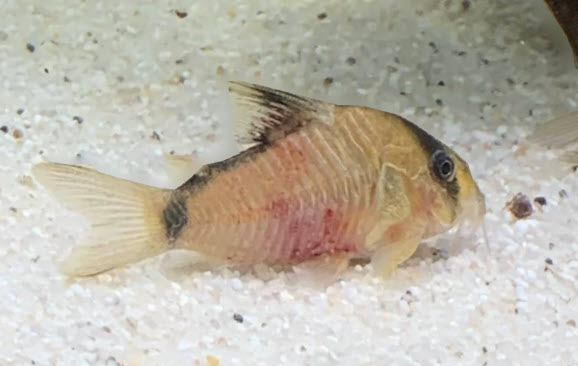
Summary
If one has more than one fish with a bacterial disease, one must treat the whole aquarium. This is an emergency. Don’t fool around with herbs, tree leaf oils or some ineffective treatment. Ben Ochart treated a bacterial infection with Pimafix and Melafix. They did nothing to stop the infection. He lost a lot of large beautiful fish before he stopped the infection with antibiotics and sulfa drugs. This link covers the snake oil medications such as Melafix and Pimafix:
12.4.1. Natural Medications
The entire topic of bacterial infections in tropical aquarium fish is covered in more detail in this link:
10.3.11. Treating Bacteria
Return to Disease Menu
Return to Bacterial Menu
.
Aquarium Science Website
The chapters shown below or on the right side in maroon lead to close to 400 articles on all aspects of keeping a freshwater aquarium. These articles have NO links to profit making sites and are thus unbiased in their recommendations, unlike all the for-profit sites you will find with Google. Bookmark and browse!
.

Dave says
In reply to Jake ….. Here is the link with citations: http://aquariumscience.org/index.php/12-5-fish-dont-drink/
Jake says
“Bacterial infections are most effectively treated with antibiotics in the food. Many believe (and the instructions on the antibiotics say!) that antibiotics need to be added to the water. They are simply incorrect. This controversial topic is covered in the following link:”
Could you provide a citation? The link is missing. Very helpful website (it would be great to get reviewed by an aquatic veterinarian).
Dave says
In reply to Victoria …… You goldfish has the fish equivalent of two black eyes. There is no medication. He will simply have to heal on his own over time.
victoria mccarty says
I thought my 7-year-old goldfish that i thought had flukes (not gill flukes but body flukes) I found an ulcer by his back tail fin so I put him in the hospital tank along with his mate and proceeded the treating both both of them with melafix it was day 6 when the male shot up and out of the tank hit the top of the cover of the tank and went to the bottom of the tank laid there for a while then I noticed one of his eyes started bulging out and was filling up with blood and then later on in the afternoon his other eye did the same thing and it looks like I can almost see where he hit the top of the cover of the tank he’s now swimming at the bottom of the tank his when he does try to swim upwards he does like a like a tornado movement like a spiral swim he’s been swimming in circles around the tank along with the other goldfish I got two goldfish one of them is like a foot long and the other ones about the one that hurt himself is 8 inches long and weighs about a pound and a half the female is 12 inches and two and a half pounds probably I believe he has internal bleeding he is a totally white fish so you can really see the brusing hie eyes are poped out of his head and there is a mark straight across his head this happened about 12 to 14 hrs ago im going for the neclear option it’s horrible but if you could give me some advice on how to help this guy would be greatly appreciated thank you very much and thanks for your website very informative
Dave says
In reply to Reva …. You should be able to use the tank, substrate and equipment after just a cleaning and letting it set for a few weeks. The bacterial levels will be reduced to “non-pathogenic” levels. It is virtually impossible to eliminate a bacteria completely from any tank and the septicemia germ is found floating in the air. Sorry for your losses.
Reva Katz says
I lost all my 11 goldfish that I had for over a decade to septicemia. I was out of town and my husband didn’t recognize it. By the time I got home, nothing worked. If I decide to get more fish, can I safely use the tank, substrate and equipment after a general cleaning? Should I replace everything but the tank (75 gallon) ??